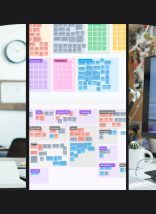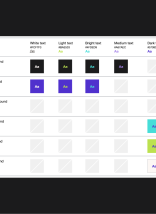Think about a brand you experienced in the past that made you feel happy. It could be a one-time thing, or maybe it’s a brand you’ve interacted with frequently. Think about the things that made you feel this way, like delightful products, friendly customer service, or honest communication. Brands can have a powerful impact on people’s lives and emotions, and it’s safe to say that they don’t go in hoping for a substandard experience.
Similar to a walking inside a store, your website or application is one of many gateways for your audience to engage with your brand. How do you think your audience feels about your brand right now?
Branding demands commitment. It demands a commitment to connect with people and stir their emotions. It demands a commitment to imagination. Many brands are only given one shot to engage people. Regardless of what you believe, people will quickly evaluate you and your brand when looking at your website or application.
The care you put into your website and brand reflect the attention you put into your product and services. Consider this: if your content is valuable, someone might assume you believe in clear communication, honesty, and care for customers. If your content is wasteful, contains broken links, or is surrounded by confusing navigation, someone might assume you lack a commitment to quality. Don’t do the latter.
Establishing and growing a brand—including a website or application —takes careful craftsmanship, commitment, and dedication. Brands are organic in nature, so they need to be cared for over time or they’ll eventually die off. The way in which you approach branding can allow you to speak volumes about your priorities, culture, trustworthiness, and level of expertise.

Is Visual Appeal Enough to Create a Trustworthy Brand?
Are there any intrinsic biases that we have as a species that prevent us from making calculated and good decisions? Yes, there are. Mainly beauty.
Beauty can influence whether we decide to walk into a store in person or explore deeper into a store online. It’s quite fascinating to observe how our behaviors and inclinations translate between offline and online existences.
As aesthetically-oriented humans, we are psychologically hardwired to trust beautiful people. In fact, research conducted by the University of Melbourne found that visually attractive websites or applications were perceived as more trustworthy than those that were unattractive.
Credibility begins with aesthetics. Whether or not a website or application has credible content, a beautiful user interface can give people the impression that the brand pays attention to detail and quality.
If your organization does not value design at its core, your brand—and your organization—will inevitably fail.
However, visual appeal alone isn’t enough to make your brand trustworthy. Beauty is only skin deep, right? The largest source of frustration from people on the web is the inability to find the right information. What’s important here is that your website or application should not only have a professional appearance, but also should have both logical structure and friendly navigation.
Connecting Brand Value to Real People
Pretty website or application—check. Logical structure—check. Friendly navigation—check. Valuable content—uh oh! Ultimately people will still struggle to get what they came for if your content isn’t written properly and adds value.
Common Reasons Your Content Fails:
- It’s too vague, complex, or full of jargon.
- It’s either too shallow or too full of meaningless words.
- It’s incorrect, outdated, or unverified.
- It’s simply boring.
- Timing is off: it’s not customized to a user’s journey.
Even if you have information perfectly aligned the way your audience wants it, timing can also determine a content’s value. Providing the right amount of information at the right time is the key. A solid content strategy can help your brand find the right balance, presenting users with highly relevant information depending on their pain points.
Characteristics of Effective Content:
- Speaks to the human reader.
- Tells the reader what they need to know, when they need to know it.
- Reduces confusion through consistent, concise wording.
- Provides value and freshness.
Additionally, where appropriate, effective content shows personality, telling the audience that the brand has the capacity to truly appreciate what matters the most to people.
Simple & Effective Ways to Build Brand Credibility
With passion and attention to detail, you can design a website or application that expresses your brand while building credibility. Let’s go over a few of the commonly-used, proven design principles that can help build that brand credibility.
Design “with people”—not “for people”
It’s important to understand your audience and what their objectives are so that you can connect with them. Are they here to perform an action? Soak up information? Interact with a particular process? Rather than making risky assumptions, design alongside your audience to meet their needs. It’s not only good practice to be more inclusive with them, but it will also add more credibility to your brand if they feel like they are being heard.
I believe as creative professionals, it’s not only important for us to run designs through tests to get a quantitative measure, but also to test qualitatively with humans who will actually use the end-product.
Provide Clear Navigation
Whether it’s a website or an application, navigation is one of the critical ways to allow your audience to discover your brand’s products, services, and information they seek. Every action a person takes with your brand has risk.
Your audience may be saying:
- Is what I’m looking for here? No, wait… there? Umm…
- How does this work? Ohh… is this clickable?
- Where am I at? Ugh, forget it – I’ll google it.
Is your audience willing to take a risk and explore deeper into your brand to find value, or will they become frustrated and leave? Is your brand willing to take a chance on that? Good labeling practices can alleviate those risks.
Everything should be organized and labeled in a meaningful way that makes the most sense to your audience. Stick with conventions and do not get overly creative, unless you want to risk hindering brand exploration and reduce brand confidence.
Don’t Sacrifice Usability for SEO
Believe me, the last thing you want to do is write your content in such a way that’s only meant for a robot—e.g. Google—to read. Search engines are great at understanding the type of information you have, however, they cannot decide whether your brand is worth buying into. Only people can decide that.
Focus on a people-first content strategy and allow your brand to speak naturally to your audience. Search engine optimization (SEO) should not dictate your message. Instead, use keyword research to see what topics your audience is interested in, and hold off on optimization until this human-centric content has been written.
Present Information at the Appropriate Time
It’s important to guide your audience through every step of their journey efficiently. Throughout their journeys, information needs will vary. For example, a user may begin by trying to see if you offer the services they need. On another visit, they may be interested in learning about your company’s processes. If you deliver all of this information at once, the user could be overwhelmed or discouraged with difficulty finding the information they need. On the other hand, not showing enough information can make you look like you’re hiding something.
As part of your content strategy, consider the context you’re presenting to your audience and disperse your information accordingly.
Delight Your Users Whenever Possible
Delighting your audience may vary depending on the industry you are in, but make no mistake, great design can and should delight all the same. Whether it’s the subtle animation of a button, the unique style of a photo filter, or the clever integration of a Konami code easter egg— plan something different to surprise your audience with.
Often times, it’s the little things that make the most impact, while showing there are real people behind your brand. We’re all human—so let your brand connect with us.
Final Thoughts on Branding
Branding is about creating a difference, adding value, and connecting with people. Life’s purpose is the same thing, right? What story will your life—your brand—tell people next.
This article was originally posted by Mark Riggan on Medium.







